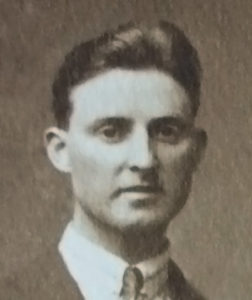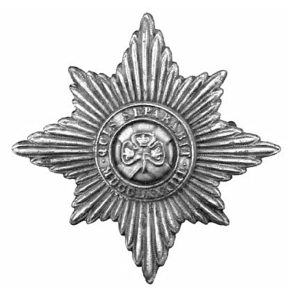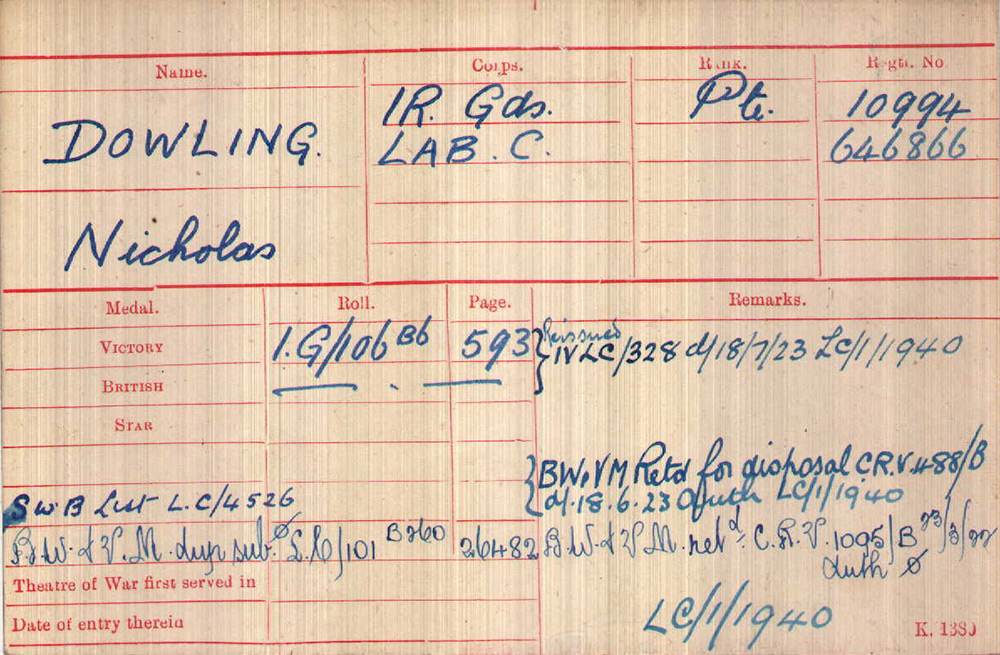Nicholas Dowling (1897-1976)
Private 10994, 2nd Battalion, Irish Guards,
Boesinghe, Ypres, 1917

Nicholas Dowling
(1897-1976)
Private 10994,
2nd Battalion, Irish Guards,
Boesinghe, Ypres, 1917



2nd Battalion, Irish Guards, Chateau de Boesinghe, Ypres,
June 1917
Prints Available – Original Sold
Family tradition has it that Nicholas, a good shot, was a Lewis Gunner during his time with the Irish Guards. I have therefore decided, following consultation with the client to show him thus armed. By his feet is a wooden ammunition box containing further ammunition.
Although the fact that by 1917 the use of various battle patches and insignia in the British Army had become widespread, the Guards kept things simple, by this time wearing only a cloth shoulder title (green with white lettering for the Irish Guards) with battalion indicators – 2 green stripes indicating the 2nd Battalion.
At his chest, Nicholas is carrying the latest gas mask – the MK2 small box respirator.
Nicholas Dowling (1897-1976)
Born: 4th September 1897, Tralee, County Kerry, Eire
Died: 20th November, 1976, Tralee, County Kerry, Eire
At 5′ 11″ to 6′ tall, the third of 7 children of Thomas Dowling and Catherine Barry, Nicholas Dowling joined the Irish Guards, being attested on the 16th February 1916, receiving the number 10994. He then spent the next few months, until that December in training, in southern England, before being shipped to France on December 22nd with the 2nd Battalion, Irish Guards. He then spent the next 8 months with the battalion in various locations in France and Belgium. He received a gunshot wound to his leg around the 14-15th August 1917, during the battle that has come to be known as Pilkhem Ridge, in the area around Ypres in Belgium, which injury saw him shipped back to the UK, to Bristol General Hospital for treatment.
Cap Badge of the Irish Guards

Nicholas’s story is thus far by no means unusual, but subsequent events were to prove somewhat more interesting.
Following treatment at the hospital in Bristol, he seems to have been given home leave, back to Ireland. Whilst on this leave he appears to have sustained another, accidental, injury, resulting in him losing part of the left-hand ring finger, which injury saw him transferred from the Irish Guards to the Labour Corps. There would appear to be some confusion as to whether or not a Court of Enquiry was held into the circumstances surrounding a possible “self-inflicted” injury, or was just formally questioned. In any event, it seems that Nicholas’ accidental version of events was accepted, whereby whilst cleaning a shotgun in his aunts’ house the gun went off, resulting in the injury to his left hand.
He was operated on at the Central Military Hospital in Cork and on 10th January 1918 was transferred to the Military Hospital Fermoy from where he was discharged on 5th February 1918 to rejoin his unit. Employed on light duties he was eventually recommended for transfer to the Labour Corps having been reassessed as Medical Category B3 , which means suitable for service overseas – ie France – but ‘sedentary’ duties only. He transferred to the Labour Corps on 5th September 1918, taking the new number of 646866.
Nicholas saw out the rest of the war in the Labour Corps, on Home Service and did not return to France. It seems that after his initial transfer to 507 Home Service Employment Company on 25th September 1918, part of Northern Command he was then posted to 366 London District: Depot Employment Company from where Nicholas was promoted to Lance-Corporal and thence posted to 685 London District: Home Service Employment Company, Labour Corps on 31st October 1918. He was eventually released from service in the British Army on 17th February 1919.
Further reading on the Labour Corps can be found on the excellent Long, Long Trail website here.
Nicholas Dowling (1897-1976)
Born: 4th September 1897, Tralee, County Kerry, Eire
Died: 20th November, 1976, Tralee, County Kerry, Eire
At 5′ 11″ to 6′ tall, the third of 7 children of Thomas Dowling and Catherine Barry, Nicholas Dowling joined the Irish Guards, being attested on the 16th February 1916, receiving the number 10994. He then spent the next few months, until that December in training, in southern England, before being shipped to France on December 22nd with the 2nd Battalion, Irish Guards. He then spent the next 8 months with the battalion in various locations in France and Belgium. He received a gunshot wound to his leg around the 14-15th August 1917, during the battle that has come to be known as Pilkhem Ridge, in the area around Ypres in Belgium, which injury saw him shipped back to the UK, to Bristol General Hospital for treatment.
Cap Badge of the Irish Guards

Nicholas’s story is thus far by no means unusual, but subsequent events were to prove somewhat more interesting.
Following treatment at the hospital in Bristol, he seems to have been given home leave, back to Ireland. Whilst on this leave he appears to have sustained another, accidental, injury, resulting in him losing part of the left-hand ring finger, which injury saw him transferred from the Irish Guards to the Labour Corps. There would appear to be some confusion as to whether or not a Court of Enquiry was held into the circumstances surrounding a possible “self-inflicted” injury, or was just formally questioned. In any event, it seems that Nicholas’ accidental version of events was accepted, whereby whilst cleaning a shotgun in his aunts’ house the gun went off, resulting in the injury to his left hand.
He was operated on at the Central Military Hospital in Cork and on 10th January 1918 was transferred to the Military Hospital Fermoy from where he was discharged on 5th February 1918 to rejoin his unit. Employed on light duties he was eventually recommended for transfer to the Labour Corps having been reassessed as Medical Category B3 , which means suitable for service overseas – ie France – but ‘sedentary’ duties only. He transferred to the Labour Corps on 5th September 1918, taking the new number of 646866.
Nicholas saw out the rest of the war in the Labour Corps, on Home Service and did not return to France. It seems that after his initial transfer to 507 Home Service Employment Company on 25th September 1918, part of Northern Command he was then posted to 366 London District: Depot Employment Company from where Nicholas was promoted to Lance-Corporal and thence posted to 685 London District: Home Service Employment Company, Labour Corps on 31st October 1918. He was eventually released from service in the British Army on 17th February 1919.
Further reading on the Labour Corps can be found on the excellent Long, Long Trail website here.


